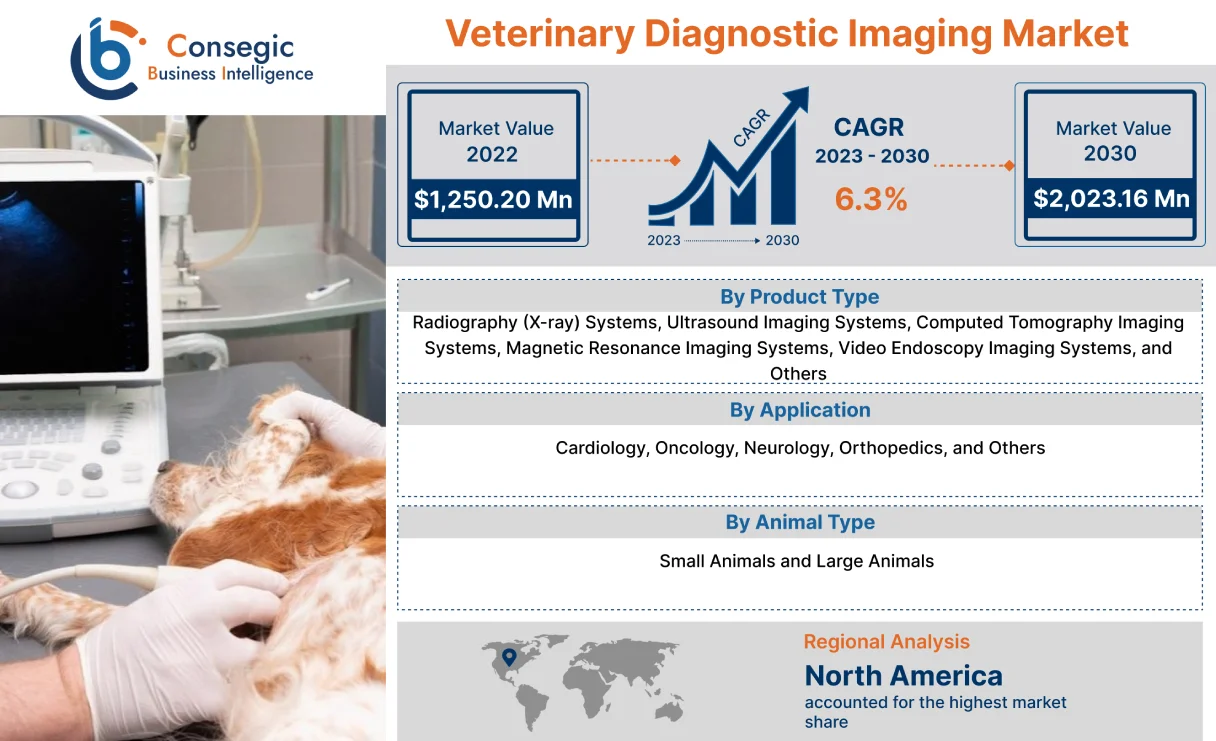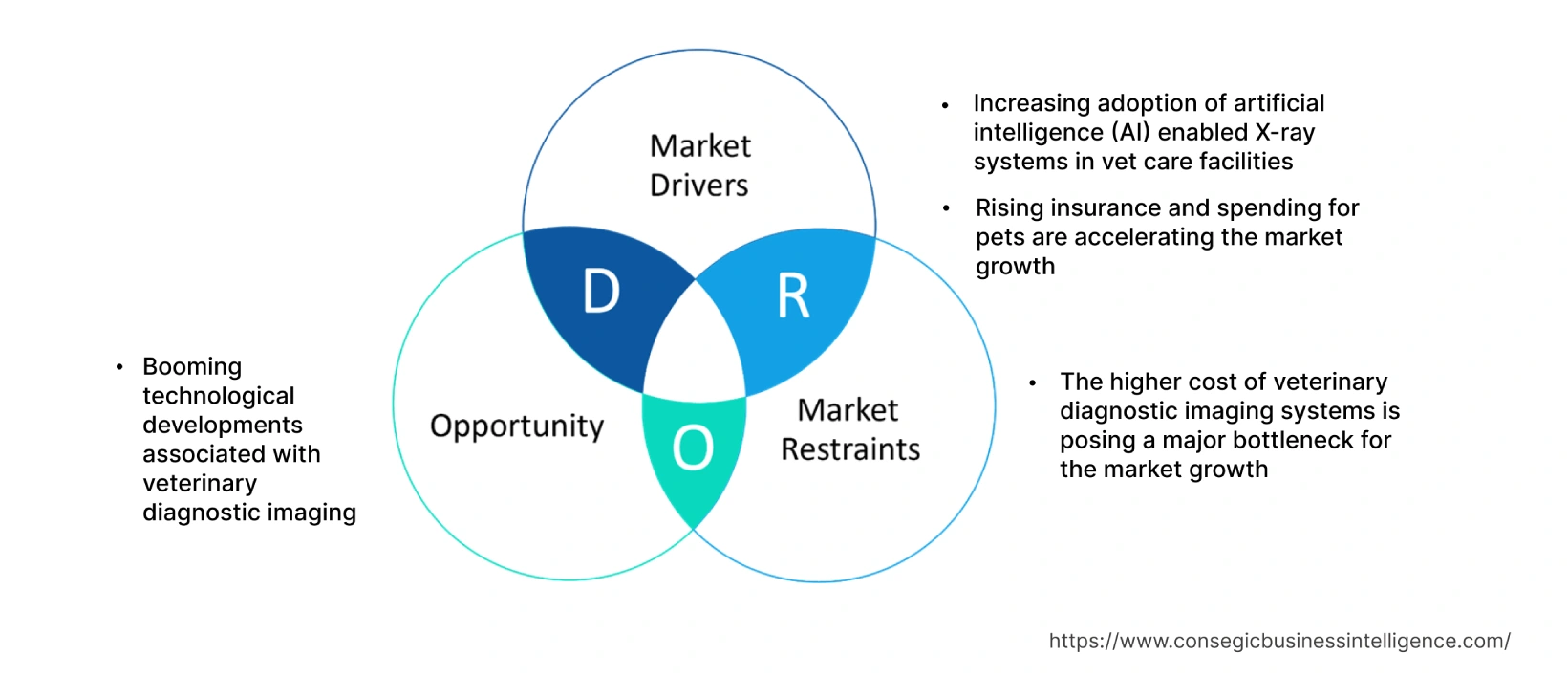- Summary
- Table Of Content
- Methodology
Veterinary Diagnostic Imaging Market Size :
Consegic Business Intelligence analyzes that the Global Veterinary Diagnostic Imaging Market size is growing with a healthy CAGR of 6.3% during the forecast period (2023-2030), and the market is projected to be valued at USD 2,023.16 Million by 2030 from USD 1,250.20 Million in 2022.
Veterinary Diagnostic Imaging Market Scope & Overview:
Veterinary diagnostic imaging is a non-invasive technique of conducting medical images of animals to diagnose various diseases. It ensures high-quality imaging and compassionate clinical care to animals. The major types of diagnostic imaging include radiography (X-ray) systems, ultrasound imaging systems, and magnetic resonance imaging systems, among others. The above product types are utilized in the veterinary domain to efficiently detect tumors, fractures, infections, injuries, and deformities. Furthermore, the imaging solution enables the veterinarian to determine which other tests may be required to make a diagnosis for animals. As a result of the superior performance properties mentioned above, the imaging solution is utilized in various applications, including cardiology, oncology, neurology, orthopedics, and others.
Veterinary Diagnostic Imaging Market Insights :
Key Drivers :
Increasing adoption of artificial intelligence (AI) enabled X-ray systems in vet care facilities spurs the market
Artificial intelligence (AI)-enabled x-ray systems for veterinary applications increase the resolution of the images. These improved images can be fed to other artificial intelligence (AI) tools for conducting the radiology workflow. The prime benefits associated with veterinary artificial intelligence (AI)-enabled x-ray systems include enhanced analysis, superior accuracy in classifications, quicker results, generating 3D models, and others. For illustration, in September 2022, Mars Inc., which operates over 2,500 veterinary centers at the global level adopted veterinary artificial intelligence (AI)-enabled x-ray systems. Also, in 2022, Bristol which operated more than 2,300 veterinary centers in Europe and Canada utilized artificial intelligence (AI)-enabled x-ray systems for veterinary applications in its clinic. Evaluation of market trends concludes that the increasing adoption of artificial intelligence (AI)-)-Enabled x-ray systems for veterinary applications ensures superior accuracy in imagining, which is benefiting the market proliferation.
Rising insurance and spending for pets drive the market
The prime benefits associated with veterinary diagnostic imaging include rapid & economical transmission of copies of images, detection of diseases, and others. Evaluation of market trends concludes that the increasing pet care insurance and spending are the key trends accelerating the expansion of the market. For instance, according to the recent statistics published by the North American Pet Health Insurance Association (NAPHIA), in 2021, about 4.4 million pets in the North American region were insured, and in 2022, it was 5.36 million pets.
In 2022, the year-on-year growth rate of pet insurance in North America registered a rise of 21.7%. Furthermore, according to the American Pet Products Association (APPA), in 2021, the total spending on pets in the United States was USD 122.02 billion, and in 2022, it was USD 136.80 billion, an increase of 10.2%. Therefore, it is evident from the above data that the rising insurance for pets and spending is propelling the demand for diagnostic imaging solutions to ensure accurate diagnosis and treat the animals. This prime factor is boosting demand for veterinary diagnostic imaging.
Key Restraints :
The higher cost of imaging systems hinders the market
The overall cost structure of the veterinary diagnostic imaging system is primarily determined by the costs of production, followed by the cost of raw materials such as stainless steel, chromium alloys, and others. Furthermore, compliance with regulations, testing costs, and other factors are inducing imaging solution manufacturers to increase their product prices. Analysis of market trends concludes that factors such as higher maintenance costs, sophisticated manufacturing processes, and other factors impact the overall cost of diagnostic imaging at the global level. For instance, the average pricing of diagnostic imaging ranges between USD 25,000 to USD 50,000 per unit. Hence, the above factors are leading to the high prices restraining the market expansion.
Future Opportunities :
Booming technological developments to promote potential opportunities
The key players dealing in the veterinary diagnostic imaging product range are substantially investing in technological innovations that are ideal for small and big animals. As a result of this, product manufacturers are continuously leveraging their technological potential to develop new products with updated technological advancements. For instance, in February 2021, Fujifilm Holdings Corporation launched VXR Veterinary X-Ray Room. The product is a digital radiography system ideal for veterinary imaging applications. Analysis of market trends concludes that the launch of new products with upgraded technology is emerging as one of many veterinary diagnostic imaging market opportunities that will drive market expansion in the forecast years.
Veterinary Diagnostic Imaging Market Report Insights :
| Report Attributes | Report Details |
| Study Timeline | 2017-2030 |
| Market Size in 2030 | USD 2,023.16 Million |
| CAGR (2023-2030) | 6.3% |
| By Product Type | Radiography (X-ray) Systems, Ultrasound Imaging Systems, Computed Tomography Imaging Systems, Magnetic Resonance Imaging Systems, Video Endoscopy Imaging Systems, and Others |
| By Application | Cardiology, Oncology, Neurology, Orthopedics, and Others |
| By Animal Type | Small Animals and Large Animals |
| By Region | North America, Europe, Asia-Pacific, Latin America, and Middle East & Africa |
| Key Players | Esaote SPA, IDEXX Laboratories Inc., Epica Animal Health, Canon Medical Systems Corporation, Fujifilm Holdings Corporation, IMV Imaging, Carestream Health, Hallmarq Veterinary Imaging, Heska Corporation, and Shenzhen Mindray Animal Medical Technology Co., LTD. |
Veterinary Diagnostic Imaging Market Segmental Analysis :
By Product Type :
The product type segment is categorized into radiography (X-ray) systems, ultrasound imaging systems, computed tomography imaging systems, magnetic resonance imaging systems, video endoscopy imaging systems, and others. In 2022, the radiography (X-ray) systems segment accounted for the highest market share of 26.50% in the overall veterinary diagnostic imaging market share. Radiography (X-ray) systems are equipped with vital features such as zoom, pan, brightness adjustments, and contrast on a single exposure. Thus, radiography (X-ray) systems assist veterinarians to diagnose diseases. Moreover, radiography (X-ray) systems allow veterinarians to take accurate pictures of internal organs and bones. As a result, the vets can exactly locate foreign ingredients that the animal might have swallowed.
For instance, SK Telecom Co., Ltd., an X-ray systems manufacturer in South Korea launched an artificial intelligence-based veterinary X-ray image diagnosis assistance product range named X Caliber. The product is ideal for X-rays of dogs. Analysis of market trends concludes that the recent innovations associated with radiography (X-ray) systems for accurate analysis of results. This, in turn, is driving the segmental proliferation of the market.
However, the ultrasound imaging systems segment is expected to be the fastest-growing segment during the forecast period. The development of a new product range, increasing adoption of pets, and others are prime factors accelerating the expansion of the ultrasound imaging systems segment.
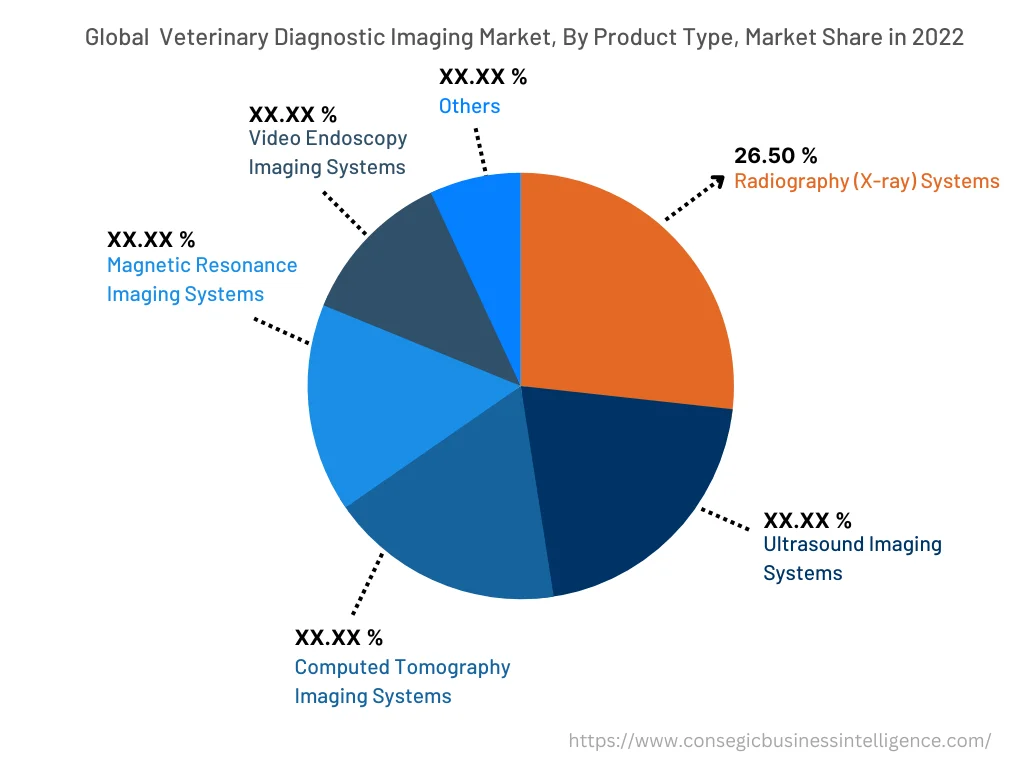
By Application :
The application segment is categorized into cardiology, oncology, neurology, orthopedics, and others. In 2022, the orthopedics segment accounted for the highest veterinary diagnostic imaging market share. Diagnostic imaging is an ideal solution for orthopedics applications due to its features, including dynamic range, spatial resolution, and real-time analysis, among others. The rise in the incidences of bone fractures due to the increase in the cases of road traffic accidents is accelerating the adoption of diagnostic imaging solutions in orthopedics to ensure accurate detection of bone fractures. Additionally, the growth in the prevalence of joint injuries in animals, the rising demand for accurate diagnostics, and an increase in recently developed modern highly advanced animal care facilities are amplifying the orthopedics diagnosis. As a result of the above-mentioned trends the adoption of the diagnostic imaging solution in orthopedics to ensure high-resolution imaging, which, in turn, is driving the veterinary diagnostic imaging market growth.
However, the oncology segment is expected to be the fastest-growing segment during the forecast period because of the development of new oncology centers for animals. For instance, in October 2021, the Southern Africa Animal Cancer Association (SAACA) in partnership with the University of Pretoria introduced an oncology centre for animal treatment in South Africa.
By Animal Type :
The animal type segment is bifurcated into small animals and large animals. In 2022, the small animals segment accounted for the highest market share in the veterinary diagnostic imaging market. The diagnostic imaging solution provides a comprehensive, multimodality diagnosis of diseases in small animals. Veterinary diagnostic imaging is utilized for small animals to diagnose disease in the abdomen, chest, and musculoskeletal system. For illustration, in April 2023, Hallmarq Veterinary Imaging, a veterinary diagnosis imaging manufacturer in the United Kingdom introduced zero-helium small animal 1.5T MRI aimed at small animals. The major focus of the company was to increase the presence of Hallmarq Veterinary Imaging in the global industry. Analysis of market trends concludes that the launch of a new range of products aimed at imaging small animals to ensure the accurate location of tumors and other types of diseases. This, in turn, is supplementing the proliferation of the veterinary diagnostic imaging market growth.
However, the large animal segment is expected to be the fastest-growing segment in the veterinary diagnostic imaging market demand during the forecast period. This is due to increasing disease occurrence in big animals, new technological innovations, and others.
By Region :
The regional segment includes North America, Europe, Asia Pacific, the Middle East and Africa, and Latin America.
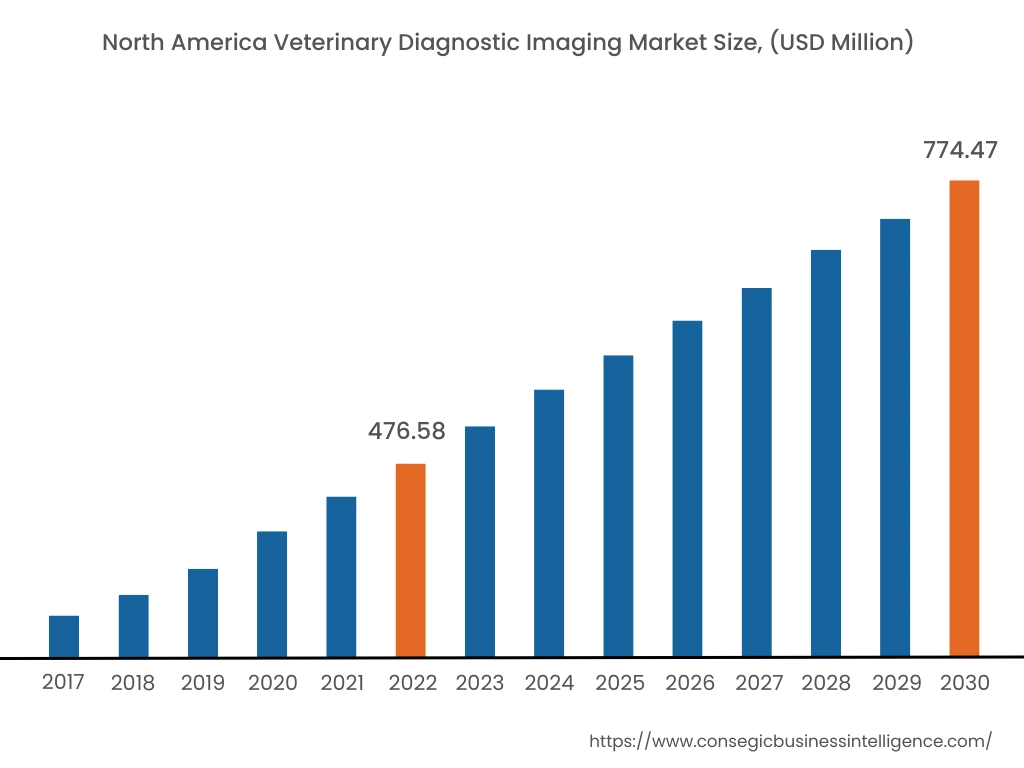
In 2022, North America accounted for the highest market share at 38.12% and was valued at USD 476.58 million, and is expected to reach USD 774.47 million in 2030. In North America, the U.S. accounted for the highest market share of 68.50% during the base year of 2022. This is due to the launch of a new range of upgraded diagnostic imaging solutions in the North American region. For instance, in January 2023, Esaote North America, Inc. launched a new range of veterinary MRIs named Magnifico Vet open MRI system. The product is designed for vets to ensure multiple users. Furthermore, the diagnostic imaging solution is an efficient vet-centric scanning product range consisting of imaging animals of various sizes quickly and easily. Analysis of veterinary diagnostic imaging market trends concludes that the launch of a new range of products in North America to ensure streamlined data for animals is favoring the growth of the market in the region.
Furthermore, Asia Pacific is expected to witness significant growth over the forecast period, growing at a CAGR of 6.9% during 2023-2030. The veterinary diagnostic imaging market analysis concluded that this phenomenon is attributed to the growing demand for veterinary diagnostic imaging from various applications, including cardiology, oncology, neurology, orthopedics, and others.
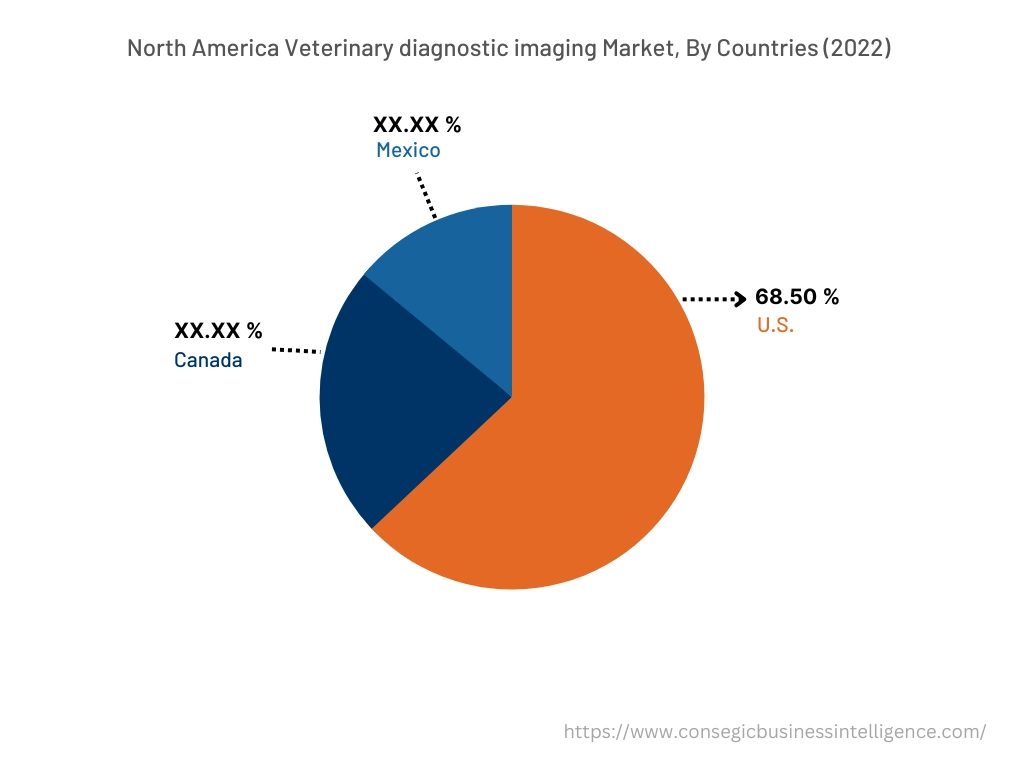
Top Key Players & Market Share Insights:
The veterinary diagnostic imaging market is highly competitive, with several large players and numerous small and medium-sized enterprises. The major companies operating in the veterinary diagnostic imaging industry have strong research and development capabilities and a strong presence in the market through their extensive product portfolios and distribution networks. The market is characterized by intense competition, with companies focusing on expanding their product offerings and increasing their market share through mergers, acquisitions, and partnerships. The key players in the market include-
- Esaote SPA
- IDEXX Laboratories Inc.
- Hallmarq Veterinary Imaging
- Heska Corporation
- Shenzhen Mindray Animal Medical Technology Co., LTD.
- Epica Animal Health
- Canon Medical Systems Corporation
- Fujifilm Holdings Corporation
- IMV Imaging
- Carestream Health
Recent Industry Developments :
- In February 2022, Asian Medical Systems, a medical equipment manufacturer in the United States, expanded into the veterinary imaging industry with the addition of MedDream VET DICOM ViewerMedDream VET DICOM Viewer. Thus, the expansion of the veterinary diagnostic imaging portfolio is fostering market growth.
- In January 2022, ClariusMobile Health, based in Canada, launched a third-generation product line of high-performance handheld wireless ultrasound scanners ideal for veterinary applications. The product is 30% lighter and smaller as compared with traditional imaging systems. Thus, the introduction of a new range of compact ultrasound devices is benefiting the market growth.
- In November 2021, Adaptix, a leading manufacturer in the United Kingdom introduced a 3D Veterinary Imaging System. The product has the potential to transform dental and orthopedic imaging. Thus, the introduction of new technologies will accelerate the growth of the market in the upcoming years.
Key Questions Answered in the Report
What was the market size of the veterinary diagnostic imaging industry in 2022? +
In 2022, the market size of veterinary diagnostic imaging was USD 1,250.20 million.
What will be the potential market valuation for the veterinary diagnostic imaging industry by 2030? +
In 2030, the market size of veterinary diagnostic imaging will be expected to reach USD 2,023.16 million.
What are the key factors driving the growth of the veterinary diagnostic imaging market? +
Increasing adoption of artificial intelligence (AI) enabled X-ray systems in vet care facilities is driving the global veterinary diagnostic imaging market growth.
What is the dominating segment in the veterinary diagnostic imaging market by product type? +
In 2022, the radiography (X-ray) systems segment accounted for the highest market share of 26.50% in the overall veterinary diagnostic imaging market.
Based on current market trends and future predictions, which geographical region is the dominating region in the veterinary diagnostic imaging market? +
North America accounted for the highest market share in the overall veterinary diagnostic imaging market.
